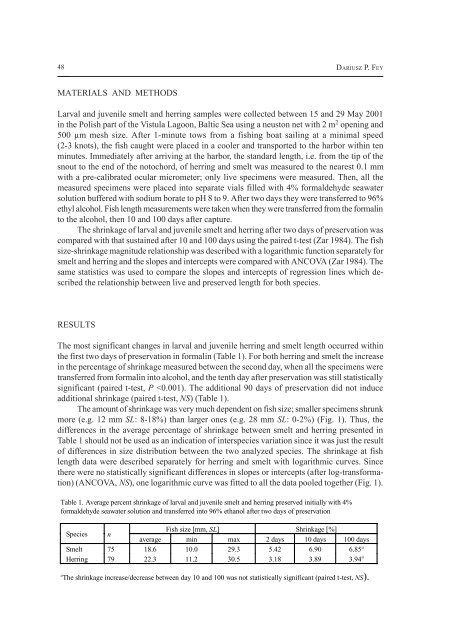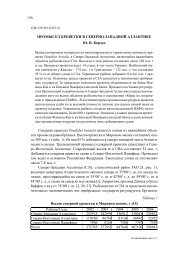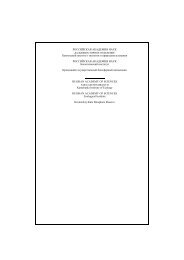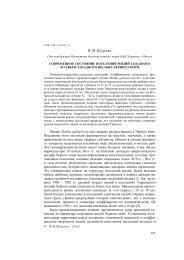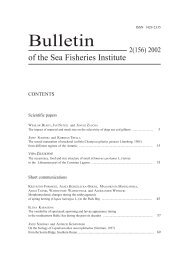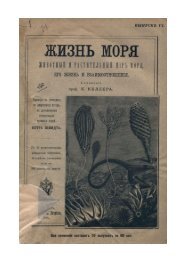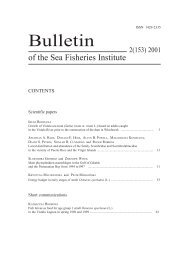Bulletin of the Sea Fisheries Institute 1 (155) 2002 - CEEMaR
Bulletin of the Sea Fisheries Institute 1 (155) 2002 - CEEMaR
Bulletin of the Sea Fisheries Institute 1 (155) 2002 - CEEMaR
You also want an ePaper? Increase the reach of your titles
YUMPU automatically turns print PDFs into web optimized ePapers that Google loves.
48<br />
DARIUSZ P. FEY<br />
MATERIALS AND METHODS<br />
Larval and juvenile smelt and herring samples were collected between 15 and 29 May 2001<br />
in <strong>the</strong> Polish part <strong>of</strong> <strong>the</strong> Vistula Lagoon, Baltic <strong>Sea</strong> using a neuston net with 2 m 2 opening and<br />
500 µm mesh size. After 1-minute tows from a fishing boat sailing at a minimal speed<br />
(2-3 knots), <strong>the</strong> fish caught were placed in a cooler and transported to <strong>the</strong> harbor within ten<br />
minutes. Immediately after arriving at <strong>the</strong> harbor, <strong>the</strong> standard length, i.e. from <strong>the</strong> tip <strong>of</strong> <strong>the</strong><br />
snout to <strong>the</strong> end <strong>of</strong> <strong>the</strong> notochord, <strong>of</strong> herring and smelt was measured to <strong>the</strong> nearest 0.1 mm<br />
with a pre-calibrated ocular micrometer; only live specimens were measured. Then, all <strong>the</strong><br />
measured specimens were placed into separate vials filled with 4% formaldehyde seawater<br />
solution buffered with sodium borate to pH 8 to 9. After two days <strong>the</strong>y were transferred to 96%<br />
ethyl alcohol. Fish length measurements were taken when <strong>the</strong>y were transferred from <strong>the</strong> formalin<br />
to <strong>the</strong> alcohol, <strong>the</strong>n 10 and 100 days after capture.<br />
The shrinkage <strong>of</strong> larval and juvenile smelt and herring after two days <strong>of</strong> preservation was<br />
compared with that sustained after 10 and 100 days using <strong>the</strong> paired t-test (Zar 1984). The fish<br />
size-shrinkage magnitude relationship was described with a logarithmic function separately for<br />
smelt and herring and <strong>the</strong> slopes and intercepts were compared with ANCOVA (Zar 1984). The<br />
same statistics was used to compare <strong>the</strong> slopes and intercepts <strong>of</strong> regression lines which described<br />
<strong>the</strong> relationship between live and preserved length for both species.<br />
RESULTS<br />
The most significant changes in larval and juvenile herring and smelt length occurred within<br />
<strong>the</strong> first two days <strong>of</strong> preservation in formalin (Table 1). For both herring and smelt <strong>the</strong> increase<br />
in <strong>the</strong> percentage <strong>of</strong> shrinkage measured between <strong>the</strong> second day, when all <strong>the</strong> specimens were<br />
transferred from formalin into alcohol, and <strong>the</strong> tenth day after preservation was still statistically<br />
significant (paired t-test, P


